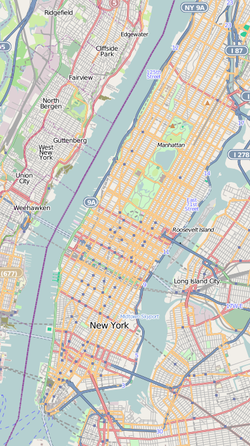Ukrainian Institute of America
|
Harry F. Sinclair House
|
|
 |
|
| Location | 2 East 79th Street and Fifth Avenue, Manhattan, New York City, New York |
|---|---|
| Coordinates | 40°46′36.3″N 73°57′49″W / 40.776750°N 73.96361°WCoordinates: 40°46′36.3″N 73°57′49″W / 40.776750°N 73.96361°W |
| Built | 1897–1899 |
| Architect | C. P. H. Gilbert |
| Architectural style | French Gothic |
| NRHP reference # | 78001882 |
| Significant dates | |
| Added to NRHP | June 2, 1978 |
| Designated NHL | June 2, 1978 |
The Harry F. Sinclair House is a mansion at 2 East 79th Street at Fifth Avenue, Manhattan, New York City, that houses the Ukrainian Institute of America, which promotes art and literature by hosting exhibitions open to public, among other means.
It was designed by Charles Pierrepont Henry Gilbert (C. P. H. Gilbert) for the New York banker and stockbroker Isaac D. Fletcher in 1897 and completed in 1898. When Fletcher died in 1917, he left the house and his art collection to the Metropolitan Museum of Art, which sold the house to create the Fletcher Fund for purchases of prints and drawings. The purchaser in 1918 was the self-made oil millionaire Harry F. Sinclair, who lived in the house until 1930. Sinclair is best known for founding Sinclair Oil in 1916 and was made notorious by his involvement in the Teapot Dome scandal in 1922. After Sinclair sold it in 1930 it became known as the Augustus and Anne van Horne Stuyvesant House; the unmarried brother and sister, descendents of Peter Stuyvesant, had moved from their house at 3 East 57th Street, when that stretch of Fifth Avenue had become unalterably commercial. Since 1955 it has been owned by the Ukrainian Institute of America.
In 1996 architectural historian Christopher Gray quoted an anonymous critic writing for the Real Estate Record & Guide in 1899, who in praising the design noted that much of the ornament was ecclesiastical in origin rather than domestic. The writer closed with the observation that the Fletcher mansion had "too much the air of an archeological reproduction to be accepted as an appropriate New York City house of 1898."
It was declared a National Historic Landmark in 1978, and remained "refreshingly unrestored", according to Christopher Gray, until 1997, when modest renovations were undertaken.
...
Wikipedia



